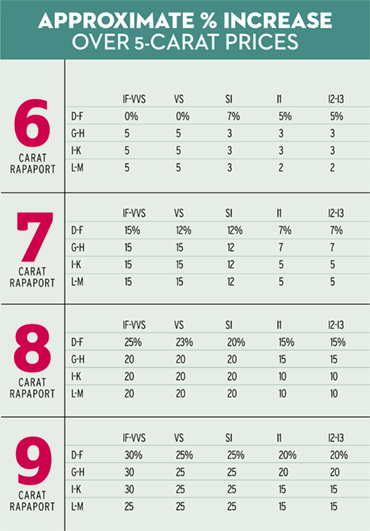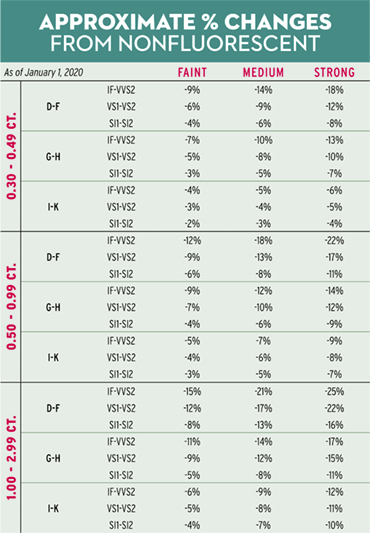Shape
Price Lists are published for Round and Pear shaped diamonds. Prices are published
every midnight Thursday. The Pear ShapePrice List is often used for other fancy
shapes with varying discounts depending on the shape, size, and quality. It is important
to note that fancy prices are highly sensitive to the shape and cut of the stone.
Poorly cut stones often trade at huge discounts. The Price List is based on well-shaped,
fine-cut stones.
Size
The Price Lists are organized by size, color and clarity. Each size has its own
matrix. Round prices are quoted for sizes from .01 carat to 10-carat sizes and fancy
shape prices are quoted for sizes from 1/5 carat to 5 carats. Approximate price
conversion scales are published for 6-carat to 9-carat sizes in the monthly Report.
Conversion scales are based on percentage increases from 5-carat prices. Large stones
often trade at premiums to the 5-carat list.

Price Indications for 6- to 9-Carat Stones
These indications should only be used as guidelines. Large stones are very thinly
traded and prices may vary significantly from dealer to dealer and stone to stone.
Current availability of large, better-quality stones is very limited and buyers
may find that asking prices and/or transaction prices may be significantly higher
or lower than these price indications. This price information should only be used
as a general indication of the current market.
Color and Clarity
Each matrix has a vertical column of colors and a horizontal row of clarities. The
colors are based on Gemological Institute of America (GIA) standard terminology
from D through M. Clarity grades are also based on GIA standards. We have, however,
added an SI3 clarity grade that is not recognized by the GIA. SI3 is a split SI2/I1
grade. It is included because sellers frequently sell this grade of stone and trade
it in the market. For sizes under 1/4 carat, colors and clarities are grouped together,
as these stones are most often sold in parcels.
Prices
All price indications are quoted in hundreds of dollars per carat. For sizes under
1/3 carat, prices are quoted to the nearest $10. For example, a price of 6.4 should
be read as $640 per carat. Sizes of 1/3 carat and larger are quoted to the nearest
$100 per carat. For example, a price of 95 should be read as $9,500 per carat. Prices
that have increased since the last price sheet are in bold. Prices that have decreased
are in italic bold.
Indexes
For 1/3 carat and larger rounds, there are two Rapaport Diamond Indexes under each
matrix. The first index RDI, W (white) is the average price per carat of all better-quality
(D to H, IF to VS2) stones of that size. The second index RDI,T (total) is the average
price of all the stones (D to M, IF to I3) in the matrix. The indexes are followed
by an = sign and a number that reflects the percentage change in the index since
the previous Price List. All indexes are in hundreds of dollars per carat.
Cut
Cut has an important impact on price. A poorly cut, flat or deep diamond is worth
substantially less than a well-cut diamond. The price information in the Rapaport
Diamond Report relates to fine-cut stones as per Rapaport Specification A3 or better (click
here for more about Rapaport Specifications). While medium-cut diamonds often trade
at a slight discount to fine-cut stones, poorly cut stones can trade at very high
discounts. Prices for fancy shape stones are highly dependent on the overall shape
and the quality of cut, with very large discounts for poorly shaped or cut fancies.
Cut Specifications
The Rapaport Price List is based on Rapaport Specification A3 or better stones without strong or
medium fluorescence. Please Note: Rapaport specifications cannot replace the human
factor in evaluating cut grade. Off-center culets, nonsymmetrical facet junctions,
very wavy girdles, large naturals, crown angle comments, pavilion percentages, and
the relationship between depth, table, crown, and pavilion are all factors that
affect cut. Fluorescence and graining may also impact market price. The effect of
cut on price is highly
specific to particular stones and buyers. It is often subjective and varies according
to market conditions. The specifications sheet is based on the opinion of Rapaport
regarding current market conditions and is subject to change without prior notice.

Fluorescence
In some instances, high color diamonds are adversely affected by strong and medium
fluorescence, which give the stones a milky white appearance. In recent years, buyers
have discriminated against fluorescent stones even when there is no milky white
appearance. This may be because fluorescence makes the stone's face-up color look
better and some labs have a tendency to upgrade the color for these stones. For
lower J to M color stones, fluorescence may have a beneficial impact on color and
may help the stone bring better prices. In some markets, such as Singapore, the
right type of fluorescent stones can bring premium prices.The Price List is based
on stones without strong or medium fluorescence. The table on the right presents
estimates of discounts and premiums for fluorescent stones.
Grading Reports and Certs
Our Price List reflects the value of stones that are accurately graded. Except for
SI3, the price list is based on Gemological Institute of America (GIA) grading standards.
Stones customarily lab graded by the trade (0.50+, D to K, IF to VS2) are priced
based on their having GIA reports. Prices for smaller and lower-quality diamonds
are based on honest grading. Stones with non-GIA certificates may trade at discounts
to stones with GIA reports.
CAUTION: Diamond grading laboratories use subjective methods of analysis. The same
diamond may be evaluated differently each time it is submitted to a laboratory.
The accuracy of a grading report, its authenticity, date, and the lab that issued
the report can all have an impact on value. Readers should be familiar with GIA
terminology and grading standards to use the Price List effectively.
|